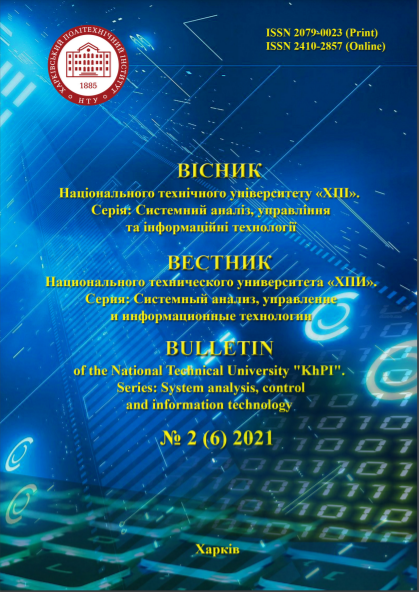AN APPROACH TO ANALYSIS OF ARCHIMATE APPLICATION ARCHITECTURE MODELS USING THE SOFTWARE COUPLING METRIC
DOI:
https://doi.org/10.20998/2079-0023.2021.02.11Keywords:
applications architecture, software engineering, software design, model analysis, software metrics, coupling metricAbstract
Applications architecture is the baseline of any organizational activity, which main goal is to provide the executional environment for business
processes in order to deliver products or services to satisfy customer needs and generate revenue. Nowadays, large software engineering projects
always begin with the architecture design phase, despite the waterfall or agile methodology is used by a software development team. Applications
architecture design is the most important and, at the same time, error-prone stage of the whole software engineering project. It is well-known that
design shortcomings made on the design phase may increase drastically to testing and maintenance phases. Further costs to defects fixing may be
hundred times higher in the later project stages in compare to the design stage on which applications architecture is defined. Common system design
solutions, which were proven on practice and used in many projects, are known as architectural patterns. Software architecture patterns are considered
as building block for system implementation. The most popular and efficient way to share architectural patterns are graphical models that used as any
other blueprints of engineering solutions. Applications architecture models are built to represent system design, whereas, such models are already
based on certain patterns as the industry best practices. Hence, in this paper we consider a relevant problem of applications architecture models
analysis, which relevance is defined by those fact that designed blueprints of information systems and other software solutions should be carefully
checked for all presumable inefficiencies in order to avoid extra efforts and related costs for defects fixing in the later project stages. It is proposed to
use ArchiMate enterprise architecture modeling language, since it can be used not only to represent applications architecture, but is connection to
business and technology layers. In order to evaluate applications architecture models, respective ArchiMate metamodel is considered and represented
as labeled directed graph, and coupling software metric is selected for analysis. Sample calculations are demonstrated, obtained results are discussed,
conclusion and future work directions are formulated.
References
Tekinerdogan B. et al. Quality concerns in large-scale and complex software-intensive systems. Software Quality Assurance. Large Scale and Complex Software-Intensive Systems. 2016, pp. 1–17.
Attribute Driven Design. Available at: http://safordevs.blogspot.com/2015/07/attribute-driven-design.html (accessed 10.02.2021).
Wojcik R. et al. Attribute-Driven Design (ADD), Version 2.0. Carnegie Mellon University, 2006. 55 p.
Making Tradeoffs and Choices. Available at: https://www.evolute.be/thoughts/atam.html (accessed 18.02.2020).
Kazman R. et al. The Architecture Tradeoff Analysis Method. Proceedings of ICECCS98. 1998, pp. 1–11.
Read TOGAF Enterprise Architecture. Available at: https://developpaper.com/read-togaf-enterprise-architecture (accessed 03.03.2021).
Vicente M. et al. Using ArchiMate and TOGAF to Understand the Enterprise Architecture and ITIL Relationship. Lecture Notes in Business Information Processing. 2013, no. 148, pp. 134–145.
ArchiMate Specification. Available at: https://pubs.opengroup.org/architecture/archimate3- doc/chap04.html#_Toc10045299 (accessed 04.03.2021).
Aulkemeier F. et al. A Service-Oriented E-Commerce Reference Architecture. Journal of Theoretical and Applied Electronic Commerce Research. 2016, no. 1 (11), pp. 26–45.
Klimek R., Szwed P. Verification of ArchiMate process specifications based on deductive temporal reasoning. Federated Conference on Computer Science and Information Systems. 2013, pp. 1103–1110.
Ingeno J. Software Architect’s Handbook: Become a successful software architect by implementing effective architecture concepts. Packt Publishing Ltd, 2018. 594 p.
Software Engineering – Coupling and Cohesion. Available at: https://www.geeksforgeeks.org/software-engineering-coupling-andcohesion/ (accessed 20.04.2021).
Catalog of Patterns of Enterprise Application Architecture. Available at: https://martinfowler.com/eaaCatalog/ (accessed 26.04.2021).
Languages and Frameworks for Programming in 2021. Available at: https://www.whoishostingthis.com/compare/languages-andframeworks/ (accessed 28.04.2021).
Orlovskyi D., Kopp A. Enterprise architecture modeling support based on data extraction from business process models. CEUR Workshop Proceedings. 2020, vol. 2608, pp. 499–513.
Downloads
Published
How to Cite
Issue
Section
License
LicenseAuthors who publish with this journal agree to the following terms:
- Authors retain copyright and grant the journal right of first publication with the work simultaneously licensed under a Creative Commons Attribution License that allows others to share the work with an acknowledgement of the work's authorship and initial publication in this journal.
- Authors are able to enter into separate, additional contractual arrangements for the non-exclusive distribution of the journal's published version of the work (e.g., post it to an institutional repository or publish it in a book), with an acknowledgement of its initial publication in this journal.
- Authors are permitted and encouraged to post their work online (e.g., in institutional repositories or on their website) prior to and during the submission process, as it can lead to productive exchanges, as well as earlier and greater citation of published work (See The Effect of Open Access).


